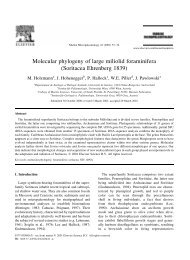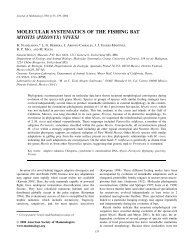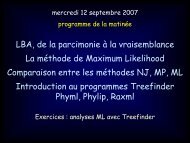Landry et al. 2006.pdf - Webspace
Landry et al. 2006.pdf - Webspace
Landry et al. 2006.pdf - Webspace
You also want an ePaper? Increase the reach of your titles
YUMPU automatically turns print PDFs into web optimized ePapers that Google loves.
TAYGETE SPHECOPHILA IN THE GALÁPAGOS ISLANDS319FIGS 18-21Pupa of Tayg<strong>et</strong>e sphecophila. 18, Ventr<strong>al</strong> view; 19, Dors<strong>al</strong> view; 20, Segments 8-10; 21, Later<strong>al</strong>view.ECOLOGICAL STUDYPATTERNS OF PREDATIONAlthough egg-laying was never observed, it is possible that the fem<strong>al</strong>e mothslay their eggs within the pup<strong>al</strong> cells of P. versicolor through numerous sm<strong>al</strong>l holes of1-2 mm in diam<strong>et</strong>er that we observed on the back of the nests. In a sample of 25P. versicolor nests, the number of T. sphecophila moths found per nest varied b<strong>et</strong>ween3 and 13. However, 42 T. sphecophila larvae were recovered by PS from a rather sm<strong>al</strong>lnest collected on Santa Cruz in 2004. The food source needed for the development ofthe moth’s larvae are the wasps’ pupae which are defenseless because of their isolationin their capped cells. When ready to emerge from the wasp's cell, the moth makes adistinctive breach through the cap covering the top of the cell.DISTRIBUTION OF INFESTED NESTSThe level of T. sphecophila infestation could only be assessed for nests ofP. versicolor that were abandoned. A tot<strong>al</strong> of 103 such nests were found on the differentstudy sites on Santa Cruz Island b<strong>et</strong>ween 1999 and 2003, and 141 nests on FloreanaIsland in 1999. The percentages of nests that presented signs of predation by T. sphecophilaare given in Table 1, <strong>al</strong>ong with the veg<strong>et</strong>ation zones in which they were found.






